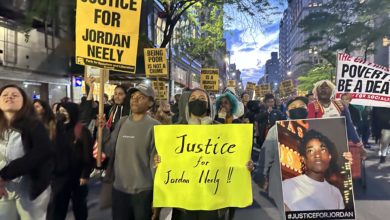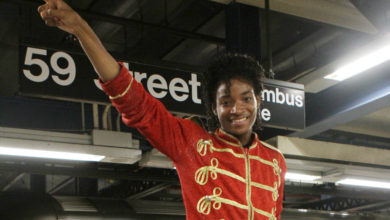Urban gentrification affects cities all across the country, driving up rents while driving out poor and working-class residents who are replaced by new residents driving luxury vehicles.
Signs of gentrification are well known. Trendy restaurants and clubs appear, leading the neighborhood to be “discovered” by well-to-do patrons. Soon, luxury rentals and lofts appear. National chain stores replace mom-and-pop commercial businesses. Neighborhoods that have been neglected for decades receive lavish city services.
 A reminder of the predominantly Latino population that resides in San Francisco’s Mission District. Photo: Bill Hackwell |
Few cities, though, have been affected by gentrification more than San Francisco. Its Mission District is a prime example. Primarily a Latino and immigrant community, the Mission has been undergoing gentrification since the “dot com” boom of the 1990s.
Once a comfortable mix of residential, commercial and industrial space, the corridor along Harrison and Bryant streets had many warehouses, garages and other light industrial establishments. But a walk down those streets today, or a quick visit to any of a number of real estate websites, reveals that those businesses have been displaced by luxury loft housing.
Home ownership is often touted as part of “the American Dream.” But in 2005, the median price of a home in San Francisco rose 16.71 percent to $847,000, making this dream an impossibility for all but the wealthy. This has fueled the trend to sell any available property rather than to rent them out—squeezing out low-income residents.
In addition to the disappearance of light industry, small apartment buildings in the Mission have been converted to tenancy-in-common condos. TICs are exempt from tenant protections in the city’s condo law. For example, tenants do not get the first right of refusal to buy their units and relocation assistance or pay, and senior or disabled tenants can be evicted. This has caused the number of evictions to skyrocket.
Especially affected by these condo conversion evictions are people with AIDS. Nearly 25 percent of these evictions are in the Castro District, the heart of San Francisco’s LGBT community. Nearly half the AIDS housing that has been created in San Francisco over the last 25 years is threatened. Already 20 to 30 percent of housing funded by the Housing Opportunities for Persons with AIDS program has been lost over the last three years.
Where are the poor, elderly and disabled to go? Certainly not to another apartment in San Francisco. According to the website Rent-SF.com, the average advertised rent for a 2-bedroom apartment in September 2006 was $3,022. With the city’s minimum wage set at $8.82 per hour, two people working full-time would not earn enough in one month before taxes to afford that.
A history of racism
Gentrification in San Francisco has been accompanied by racist displacement, typical of the national trend. Starting with the “redevelopment” of the Fillmore area in the 1960s, San Francisco’s African American population has been dwindling. In 2005, the African American population had shrunk to 46,779, just 6.5 percent of the city’s population. That is down from 79,039, or 12.4 percent, just 25 years ago.
A 2001 report by Urban Action at San Francisco State University decried the institutional racism that underdeveloped the African American areas of the city and forced the population out. Citing census data, it stated that in 1960 “African Americans accounted for between 58.9 and 68.0 percent of the population in the heart of the Fillmore.”
The report continued, “Prior to the redevelopment of the Fillmore in the 1940s and 1950s, the district was not only the main African American community in San Francisco but also a vibrant center of commercial ownership for African Americans. Of the nearly 1,000 San Francisco African American-owned businesses recorded by the Committee for Community Solidarity Inc. in 1959, 80 percent were located in the Fillmore District and nearly 100 were located on Fillmore Street proper. The area had restaurants, supper/nightclubs, pharmacies, art galleries, barber/beauty shops, doctors, dentists, lawyers, banks/finance companies, realty companies, printing and stationery stores, retail and apparel shops, butchers, bakers, markets, and everything else that a neighborhood could need.”
The San Francisco Redevelopment Agency was created in 1948 as an entity legally separate from the city, giving it freedom to designate large swaths of land as blighted, then to use the right of eminent domain to take ownership of the land at public expense and turn it over to private property developers. In this way, the agency demolished nearly half a square mile of the Fillmore in 1964, displacing 15,000 people, primarily African American.
New threats looming
San Francisco’s remaining predominantly African American community in Bayview and Hunters Point is now in developers’ sights. A light rail line has been installed along Third Street, making the long-isolated community accessible to the financial and commercial districts. A Pacific Gas and Electric power plant that had polluted the southeast part of the city for years has been closed, and the abandoned Naval Shipyard has been turned over to the Redevelopment Agency.
The Redevelopment Agency has selected the Lennar Corporation as the private developer for this publicly owned site. The agency promises that market-rate and below-market housing will be available. But with the Lennar corporate website showing other Bay Area homes it builds selling for $660,000 to $830,000, residents have reason to be skeptical.
Gentrification, urban renewal and redevelopment are in fact a form of theft by the bankers and developers from the workers and poor. Shelter is a basic necessity of life. To be deprived of that is theft enough.
But even more, long-time renters may have paid many times the value of the property in rent for their dwelling to landlords who often provide no services or maintenance. Even for those lucky enough to have bought homes, the equity could never compensate for the higher rents and property taxes should they choose to relocate in the area.
Only by eliminating the profit motive from housing and real estate can the right to housing be truly guaranteed. Otherwise, this basic right will always be controlled by real estate speculators and slumlords.
Countries that are much poorer than the United States have been able to provide this right by organizing society along socialist lines, for people’s needs instead of for private profit. Countries like Cuba and North Korea are able to guarantee home ownership or rentals for less than 10 percent of one’s salary.
But as long as the economic system is organized to serve the bankers and landlords, every home and community is threatened.
There has been a consistent fight against gentrification in San Francisco over the years. Many times, communities have been able to win concessions from the city and developers.
Those struggles continue. The Community First Coalition is leading the fight against the gentrification of Bayview-Hunters Point, along with Greenaction, the San Francisco Bayview newspaper, churches and others. Whether through protests at City Hall by AIDS activists, marches through the Mission or sit-ins and takeovers when needed, this community has pledged not to give up without a fight.






